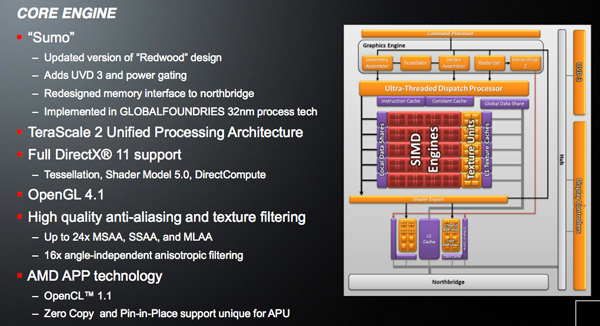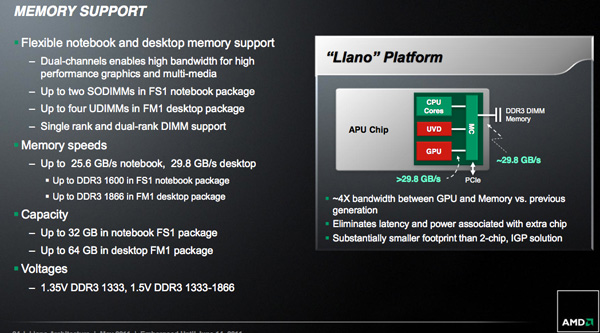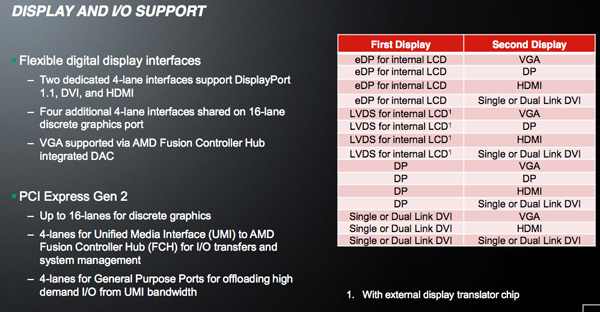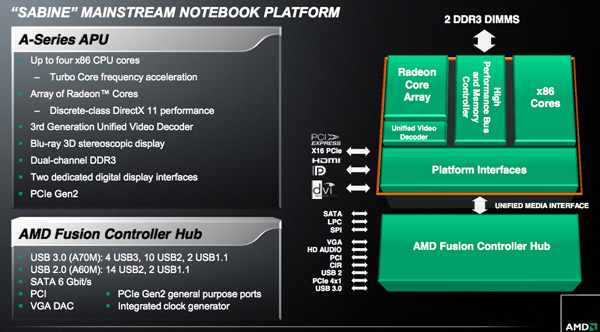The AMD Llano Notebook Review: Competing in the Mobile Market
by Jarred Walton & Anand Lal Shimpi on June 14, 2011 12:01 AM ESTThe GPU
While the Llano CPU cores may be in need of a major overhaul, Llano's GPU is as new as it gets. Technically based off of AMD's Redwood core (Radeon HD 5570) with some enhancements, Llano's GPU is codenamed Sumo.
The DX11 GPU features five SIMD arrays, each with 80 cores for a total of 400 shader processors. Similar to the updates we saw with this year's Northern Islands GPUs, Sumo does add UVD3 support to the Redwood architecture. Of course since Sumo shares the same die as the Llano CPU cores it is built on GlobalFoundries' 32nm process, making this the first AMD GPU fabbed at GlobalFoundries and not TSMC.
For everything behind the memory controller Sumo is virtually identical to Redwood. Where Sumo differs is in its memory interface. Although Llano is AMD's first performance oriented APU, it's still constrained by a 128-bit wide DDR3 memory interface. That dual-channel memory interface has to be shared by all four Llano cores as well as the Sumo GPU and as a result, arbitration is very important.
AMD shared a few choice details about the Llano memory controller architecture. To begin, AMD guarantees more than 30GB/s of bandwidth is available between the GPU and the memory controller—in other words, the path from GPU to the memory controller won't become a bottleneck. The GPU/memory controller link (i.e. within the APU die) can apparently scale up to as much as 50GB/s to support future APUs with even faster memory interfaces. Note that unlike previous integrated graphics solutions, there is no support for dedicated external memory—this is a pure shared memory architecture.
Second, and most importantly, AMD can dynamically prioritize memory bandwidth between the CPU and GPU. In most cases, when both processors are heavily consuming data, the GPU is given priority over the CPU. Given today's workloads, prioritizing the GPU for memory accesses makes sense when it's running full tilt. The chances of you stressing all four CPU cores and running at full GPU memory bandwidth requirements are pretty slim today.
With 400 shader processors behind a shared 128-bit DDR3 memory interface, the upper bound for Sumo performance is the Radeon HD 5570. In practice, you should expect performance to be noticeably lower since the GPU does have to share its precious memory bandwidth with up to four x86 CPU cores.
The mobile version of Llano supports up to DDR3-1600 while the desktop parts can run at up to DDR3-1866. Maximum memory capacities are 32GB and 64GB for notebooks and desktops, respectively.
Llano has a total of 24 PCIe Gen 2 lanes at its disposal. Sixteen of those lanes can be used for external graphics. Four of the lanes can be used for devices that need low latency/high bandwidth access to the APU itself (e.g. Gigabit ethernet). The remaining four lanes are used to connect the APU to its sole partner in crime: the Fusion Controller Hub.
AMD is particularly proud of the display output configurations supported by Llano. The possible combinations are listed below:
Chipsets
AMD will offer two Fusion Controller Hubs (FCHs) as options for Llano: A70M and A60M. The only difference between the two is in their support for USB 3.0; the A70M has four USB 3.0 ports while the A60M has none.
Both FCHs support 6Gbps SATA and perform just as well as AMD's 8-series chipset (or Intel's Z68) with a high performance SSD. USB 3.0 performance is also comparable to 3rd party solutions we've seen deployed on motherboards already.















177 Comments
View All Comments
Shadowmaster625 - Monday, June 20, 2011 - link
Can you try setting the affinity manually so that it has to use only one core? I notice that even though I'm running only one thread, that thread will jump around to all my available cores, making them all look like they are running at 25%. Maybe by the time AMD's turbo kicks in, the thread is already moved to another core.GullLars - Tuesday, June 14, 2011 - link
Looking forward to the re-test with an SSD.IMHO all machines over $600 meant for general purpose use in 2011 should include at least a 32GB SSD of Indilinx Barefoot performance or better.
My laptop from 2007 with 2,2GHz C2D and a 32GB Vertex (retrofitted in 2009) still wipes the floor with new $800+ laptops with HDD-only for general use.
JarredWalton - Tuesday, June 14, 2011 - link
Having played with a bunch of laptops using 64GB SSDs, they all feel snappier, though of course it doesn't help with gaming frame rates or CPU computations. Still, I have to say that 64GB isn't big enough for me. If you can get a 32GB mSATA SSD and some sort of SSD caching, and then have a main 500GB HDD, that would be the sweet spot. If you're going SSD-only, I need at least 120GB, and for anything that can run games I'd want 240GB. (By the time I install most of the games I'm currently interested in playing on a regular basis, I easily fill up a 120GB drive.)Anyway, I'm swapping in the SSD now and will start testing during the week, with the follow-up article hopefully ready next week. I've got DC SNB, Arrandale, DC Phenom II, E-350, and now Llano for the article. Anything else you want to request before I call it quits? I've still got the XPS L502x and an AMD K625, but I figure the five laptops are a reasonable representation of what's currently out there. (Note that I have currently focused only on IGP equipped laptops.)
Boissez - Tuesday, June 14, 2011 - link
Results with/without DDR3 RAM would be interesting as it seems RAM speed is a bottleneck.Boissez - Tuesday, June 14, 2011 - link
dang... That should have been with/without DDR3 1600 Mhz RAMBrian23 - Tuesday, June 14, 2011 - link
Application compile benchmarks. ;-)Cloudie - Tuesday, June 14, 2011 - link
The battery life has exceeded my expectations although battery life is a low priority for me when buying a laptop. As long as it gets 4 hours or so at idle is fine by me.Both the GPU and CPU performance has disappointed me somewhat but on the plus side I was not aware until now that the APU being tested was a 35W version, I simply assumed it was the fastest 45W one. Hopefully the CPU perfomance will be just that little bit better on the 45W APUs. And OEMs better get out some decent compact systems with this in... I'd say 13-14" chassis will do me just fine.
just4U - Wednesday, June 15, 2011 - link
If they can get this priced out in a $600 laptop with all the bells and whistles... It will sell. Looking locally (and online) decent gaming laptops start out at about $800. Looking at the numbers it's more then acceptable I think. Profit has to be in there though for AMD.. If their not turning an acceptable profit on each chip then... it will be a wash.duploxxx - Wednesday, June 15, 2011 - link
Looking at the recent preview of anandtech on the desktop Liano part and the increased performance from DDR1333 to DDR 1866 i would like to see what it would bring on a Mobile platform. Afterall LIano mobile does support ddr 1600http://www.anandtech.com/show/4448/amd-llano-deskt...
Germanicus - Wednesday, June 15, 2011 - link
1600 MHz DDR3 - lets make this accurate, since Llano can utilize it.Thank you.